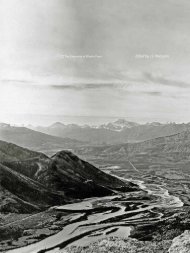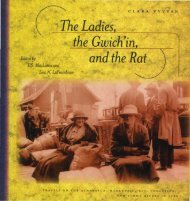Paul Kane's Journal of his Western Travels, 1846-1848 - History and ...
Paul Kane's Journal of his Western Travels, 1846-1848 - History and ...
Paul Kane's Journal of his Western Travels, 1846-1848 - History and ...
You also want an ePaper? Increase the reach of your titles
YUMPU automatically turns print PDFs into web optimized ePapers that Google loves.
characters while there; <strong>and</strong> the transfer <strong>of</strong> Rupert's L<strong>and</strong> to the<br />
Dominion <strong>of</strong> Canada was arranged there in 1869.<br />
oaId mans river A tributary <strong>of</strong> the Athabasca River, Oldman<br />
Creek enters it from the south, at a point between the mouths <strong>of</strong><br />
two other tributaries: the Berl<strong>and</strong> <strong>and</strong> the McLeod. Modem<br />
Whitecourt, Alberta, lies to the east <strong>of</strong> Oldman Creek. <strong>Kane's</strong><br />
brigade had to make two portages on the Athabasca River at<br />
t<strong>his</strong> point because <strong>of</strong> low water levels in October.<br />
Ockanagan Fort Okanagan (est. 1811) was visited by Kane<br />
November 28, <strong>1846</strong>. Situated at the forks <strong>of</strong> the Okanagan <strong>and</strong><br />
Columbia rivers (near modem Brewster, Washington),<br />
t<strong>his</strong> post was established by John Jacob Astor's Pacific Fur<br />
Company, bought, along with Astoria, by the North West<br />
Company in 1812, <strong>and</strong> taken over by the HBC in 1821, at the<br />
time <strong>of</strong> the merger with its rival.<br />
oragan Kane here uses the term (i.e. Oregon) to designate the<br />
entire Pacific Slope drained by the Columbia River: a post as<br />
far inl<strong>and</strong> as Fort Colville is included. The name was first<br />
used by Jonathan Carver, in <strong>Travels</strong> through the Interior<br />
Parts <strong>of</strong> North America (1778), <strong>and</strong> seems to derive from the<br />
Shoshoni word, oyer-un-gon. meaning" a place <strong>of</strong> plenty. "<br />
Orkey / orknie The HBC traditionally hired on men at the<br />
Orkney Isl<strong>and</strong>s, <strong>of</strong>f the northeast coast <strong>of</strong> Scotl<strong>and</strong>, which was<br />
the last stop for the company's ships before the traverse to<br />
Hudson Strait. Natives <strong>of</strong> the Orkneys are properly called<br />
Orcadians, but were known as Orkneymen in the fur trade.<br />
P. River/pambani Pembina River flows east <strong>and</strong> south out <strong>of</strong><br />
the northern Turtle Mountain, in the southwestern comer <strong>of</strong><br />
Manitoba. It crosses the Manitoba/North Dakota border <strong>and</strong><br />
empties into Red River at Pembina, North Dakota. Its name<br />
comes from the Cree for "wateIberry" or "high bush cranberry."<br />
Paganes The Piegan (U .S. sp.)/Peigan (Can. sp.) are the largest<br />
<strong>of</strong> the three tribes comprising the Blackfoot Nation. The<br />
Piegan language differs only slightly from that <strong>of</strong> the Blood<br />
<strong>and</strong> Blackfoot. T<strong>his</strong> tribe once occupied hunting grounds in the<br />
Rocky Mountain foothills, extending from Rocky Mountain<br />
House, on the North Saskatchewan River, in the north, to what<br />
today is known as Heart Butte, Montana, in the south, <strong>and</strong> east<br />
out onto the Plains. By the time <strong>of</strong> <strong>Kane's</strong> travels, they had<br />
moved farther south, but were occasional visitors to Fort<br />
Edmonton <strong>and</strong> Fort Pitt, where they chanced to encounter their<br />
traditional enemies, which included the Assiniboine.<br />
Pallaw See Pellaw.<br />
pallett <strong>Paul</strong> <strong>Paul</strong>et <strong>Paul</strong>, one <strong>of</strong> the steersmen <strong>of</strong> <strong>Kane's</strong> brigade<br />
<strong>of</strong> York boats in August, <strong>1846</strong>, was renowned for a great feat<br />
<strong>of</strong> strength that he performed at Gr<strong>and</strong> Rapid, the debouchement<br />
<strong>of</strong> the Saskatchewan River, through Cedar Lake, into<br />
Lake Winnipeg. When he accidentally snapped <strong>his</strong> steering oar<br />
<strong>and</strong> fell overboard, he managed not only to gain a footing in the<br />
ferocious rapid, but also to spring into the next boat coming<br />
downriver. Then, he urged the men to catch up to <strong>his</strong> foundering<br />
vessel; when they succeeded, he sprang into it, regained<br />
control <strong>of</strong> it before it overturned, <strong>and</strong> conducted it safely into<br />
the next lake (WA [73-74].<br />
paluse River A tributary <strong>of</strong> the Snake River, the Palouse River,<br />
The American Art <strong>Journal</strong>! Volume XXI • Number 2<br />
in southeastern Washington, drains the portion <strong>of</strong> the Columbia<br />
Basin that lies south <strong>of</strong> Spokane, Washington.<br />
pambani See P. River.<br />
Pambena MounteD Probably, Pembina mountain is meant<br />
here, but that name is not a current feature on maps. Because<br />
Kane mentions it before, but on the same day that he mentions<br />
P[ embina] River, the hill could be the one identified as Le Gros<br />
Bute on the map prepared by the British expedition, under<br />
Captain John Palliser, a decade later (1857 - 1860). T<strong>his</strong> would<br />
place the hill near the site <strong>of</strong> present~y Baldur, Manitoba,<br />
north <strong>of</strong> Rock Lake (<strong>Kane's</strong> lake de Roch) , <strong>and</strong> south <strong>of</strong><br />
Spruce Woods Provincial Parle.<br />
papeler point See Lake Winapeg.<br />
parey de bute or hill parey Neither name has survived on<br />
modem maps. <strong>Kane's</strong> l<strong>and</strong>scape <strong>and</strong> portrait log states that<br />
"Prarey de Bute" was situated "between the cow e litz <strong>and</strong><br />
Nesqually [rivers] . . . 20 miles from [Fort] Nesqually." Together<br />
with the fact that Captain Wilkes records <strong>his</strong> encountering<br />
the prairie after crossing the Deschutes River on <strong>his</strong> trip<br />
from Fort Nisqually to Fort Vancouver in May, 1841, <strong>Kane's</strong><br />
information matches the feature known today as Violet Prairie,<br />
Washington.<br />
Whereas the journal credits Captain Wilkes with having<br />
investigated the hills on the prairie, WA entrusts t<strong>his</strong> investigation<br />
to Kane himself: "I dug one <strong>of</strong> them open, but found<br />
nothing in it but loose stones, although I went four or five feet<br />
down. The whole surface is thickly covered with coarse grass"<br />
(142). For <strong>his</strong> part, Wilkes described "Bute Prairies" as<br />
"extensive, <strong>and</strong> covered with umuli or small mounds, at<br />
regular distances asunder. As far as I could learn, there is no<br />
tradition among the natives relative to them. They are conical<br />
mounds, thirty feet in diameter, about six or seven feet high<br />
above the level, <strong>and</strong> many thous<strong>and</strong>s in number. Being anxious<br />
to ascertain if they contained any relics, I subsequently<br />
visited these prairies, <strong>and</strong> opened three <strong>of</strong> the mounds, but<br />
nothing was found in them but a pavement <strong>of</strong> round stones. "<br />
the paw/the Paw/the P./the Pau The Pas (est. 1751) was<br />
visited by Kane August 25, <strong>1846</strong>, <strong>and</strong> July 12, <strong>1848</strong>. On the<br />
Saskatchewan River just east <strong>of</strong> the Saskatchewan/Manitoba<br />
border, t<strong>his</strong> post took its name from the Cree opa, a "narrow<br />
place"; the expression is descriptive <strong>of</strong> the river at t<strong>his</strong> point.<br />
It was known to the French as Pasquia <strong>and</strong> Le Pas.<br />
PeDaw /Pallaw The identity <strong>of</strong> t<strong>his</strong> voyageur is not known. See<br />
also Lefrombeys.<br />
pin portage On the Kaministikwia River upriver from<br />
Kakabeka Falls, the vicinity <strong>of</strong> t<strong>his</strong> portage, like the rapids it<br />
avoided, has been submerged by hydroelectric projects on the<br />
river.<br />
Pitt Fort Pitt (est. 1830) was visited by Kane September 19-<br />
20, <strong>1846</strong>, <strong>and</strong> Janwuy 14 to February 3, <strong>and</strong> May 27- 28,<br />
<strong>1848</strong>. On the North Saskatchewan River just east <strong>of</strong> the<br />
Alberta/ Saskatchewan border, Fort Pin served as the midway<br />
provisioning post between forts Edmonton, on the west,<br />
<strong>and</strong> Carlton, on the east.<br />
play geene lake/Play geene lake Playgreen Lake, depending<br />
upon one's point <strong>of</strong> view, is the northeastern extension <strong>of</strong> Lake<br />
81
















